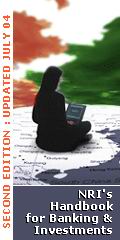|


|
India to emerge as the third largest domestic banking market in the world by 2040
-Banking in 2050: How big will the emerging markets get?
The banking sector will grow significantly faster than GDP in the ‘E7’ emerging economies of China, India, Brazil, Russia, Indonesia, Mexico and Turkey, according to new projections in a PricewaterhouseCoopers’ report ‘Banking in 2050: How big will the emerging markets get?’ Total profits from domestic banking in the E7 could be around half those in the G7 (US, Japan, Germany, UK, France, Italy and Canada) by 2025 and larger than in the G7 before 2050.
China and India show the greatest growth potential in the coming decades. Both economies are projected to lead the rise of the E7 through organic growth and M&A activity. The new projections for the banking market, using projected market exchange rates, suggest that total domestic credit in China could overtake the UK and Germany by 2010, Japan by 2025 and the US before 2050. India could also rise from relatively low levels today to emerge as the third largest domestic banking market in the world by 2040 and, in the long run, could grow faster than China.
Commented Dominic Nixon, Asia Financial Services Leader of PwC, “The E7 banking markets will become ever more important in the global banking sector. Institutions that do not develop strong positions in these markets will find it difficult to maintain the same growth rates of assets and profits as those that do.
“We expect to see continued high levels of deal activity in the E7 markets, albeit with the normal short-to-medium-term cyclical variations over time. M&A will encompass consolidation activity ‘in-market’ as local banks acquire one another, foreign banks enter the E7 markets, and banks from the E7 expand internationally through acquisitions.”
Brazil, Indonesia, Mexico, Russia and Turkey are also strong candidates for a rapid expansion of their banking sectors over time, driven in particular by strong growth in retail banking (mortgages, consumer credit) that is already becoming apparent today and has much further to go as economic development proceeds. These territories all have the potential to develop banking sectors of comparable scale to major European economies such as France and Italy before 2050.
The strategic implications of the rise of the E7 banking markets include strong growth in M&A activity both within the E7 countries (due to consolidation of often fragmented banking sectors at present) and across borders. Restructuring of the E7 economies should also create major opportunities for private equity firms. Leading E7 banks will also expand outwards and become major competitors in the global ‘war for talent’, a trend that is
already underway with Russian, Chinese and Indian banks attracting staff with experience of G7 institutions. As the E7 banks leverage the knowledge of these staff, their competitiveness in both domestic and global markets will increase.
Summarising the findings, Mr Nixon said, “The banking world in 2050 will look radically different from the one we see today, with the E7 economies becoming at least as important as the G7. This reflects both faster projected GDP growth in the E7 and the systematic tendency of banking sectors to grow faster than GDP as economies develop. The E7 markets are relatively high risk, but our analysis suggests the potential to mitigate these risks through making long-term investments in a broad portfolio of emerging banking markets.”
In a previous report, ‘The World in 2050’, published in March 2006, PwC economists predicted that by the year 2050, the ‘E7’ economies will have outstripped the current G7 by around 25% when comparing GDP using market exchange rates and around 75% when using purchasing power parity (PPP) exchange rates.
The latest report examines the possible changes in the scale of the banking sector between now and 2050 and highlights the pace of change, while providing some measure of the size of the opportunity and challenge for banks. The projections are based on an analysis of developments in G7 and E7 banking markets since the 1950s, which highlights the tendency of the banking sector to grow faster than GDP as economies develop.
(This is press release of PriceWaterhouseCoopers)
M&A in BANKS IN INDIA
CLICK FOR MORE FEATURES & STORIES
|
|


|





